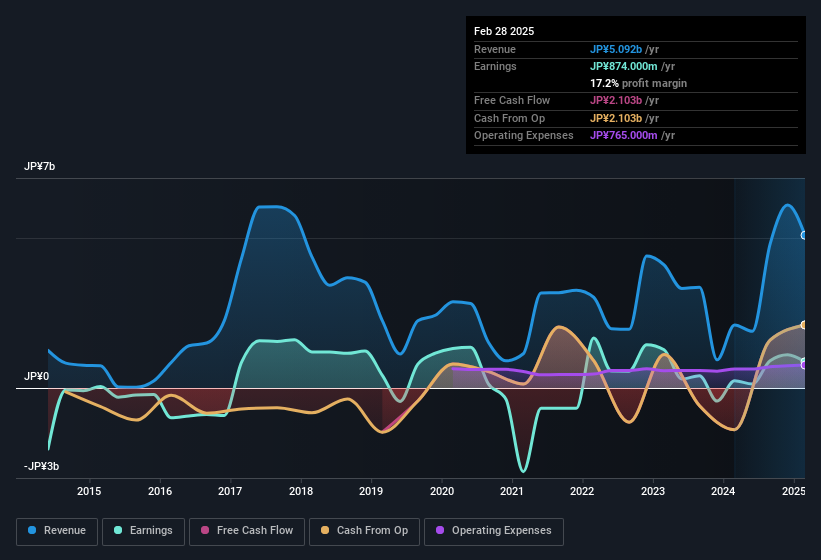- Japan
- /
- Real Estate
- /
- TSE:8918
We Think LAND's (TSE:8918) Profit Is Only A Baseline For What They Can Achieve
The subdued stock price reaction suggests that LAND Co., Ltd.'s (TSE:8918) strong earnings didn't offer any surprises. Investors are probably missing some underlying factors which are encouraging for the future of the company.
Our free stock report includes 2 warning signs investors should be aware of before investing in LAND. Read for free now.
Examining Cashflow Against LAND's Earnings
In high finance, the key ratio used to measure how well a company converts reported profits into free cash flow (FCF) is the accrual ratio (from cashflow). The accrual ratio subtracts the FCF from the profit for a given period, and divides the result by the average operating assets of the company over that time. This ratio tells us how much of a company's profit is not backed by free cashflow.
That means a negative accrual ratio is a good thing, because it shows that the company is bringing in more free cash flow than its profit would suggest. That is not intended to imply we should worry about a positive accrual ratio, but it's worth noting where the accrual ratio is rather high. To quote a 2014 paper by Lewellen and Resutek, "firms with higher accruals tend to be less profitable in the future".
Over the twelve months to February 2025, LAND recorded an accrual ratio of -0.21. That implies it has very good cash conversion, and that its earnings in the last year actually significantly understate its free cash flow. Indeed, in the last twelve months it reported free cash flow of JP¥2.1b, well over the JP¥874.0m it reported in profit. Notably, LAND had negative free cash flow last year, so the JP¥2.1b it produced this year was a welcome improvement. Notably, the company has issued new shares, thus diluting existing shareholders and reducing their share of future earnings.
Note: we always recommend investors check balance sheet strength. Click here to be taken to our balance sheet analysis of LAND.
To understand the value of a company's earnings growth, it is imperative to consider any dilution of shareholders' interests. As it happens, LAND issued 5.7% more new shares over the last year. That means its earnings are split among a greater number of shares. Per share metrics like EPS help us understand how much actual shareholders are benefitting from the company's profits, while the net income level gives us a better view of the company's absolute size. Check out LAND's historical EPS growth by clicking on this link.
A Look At The Impact Of LAND's Dilution On Its Earnings Per Share (EPS)
LAND's net profit dropped by 48% per year over the last three years. On the bright side, in the last twelve months it grew profit by 276%. But EPS was less impressive, up only 260% in that time. So you can see that the dilution has had a bit of an impact on shareholders.
Changes in the share price do tend to reflect changes in earnings per share, in the long run. So it will certainly be a positive for shareholders if LAND can grow EPS persistently. But on the other hand, we'd be far less excited to learn profit (but not EPS) was improving. For the ordinary retail shareholder, EPS is a great measure to check your hypothetical "share" of the company's profit.
Our Take On LAND's Profit Performance
At the end of the day, LAND is diluting shareholders which will dampen earnings per share growth, but its accrual ratio showed it can back up its profits with free cash flow. Considering all the aforementioned, we'd venture that LAND's profit result is a pretty good guide to its true profitability, albeit a bit on the conservative side. If you want to do dive deeper into LAND, you'd also look into what risks it is currently facing. Our analysis shows 2 warning signs for LAND (1 makes us a bit uncomfortable!) and we strongly recommend you look at these before investing.
Our examination of LAND has focussed on certain factors that can make its earnings look better than they are. But there is always more to discover if you are capable of focussing your mind on minutiae. For example, many people consider a high return on equity as an indication of favorable business economics, while others like to 'follow the money' and search out stocks that insiders are buying. So you may wish to see this free collection of companies boasting high return on equity, or this list of stocks with high insider ownership.
New: AI Stock Screener & Alerts
Our new AI Stock Screener scans the market every day to uncover opportunities.
• Dividend Powerhouses (3%+ Yield)
• Undervalued Small Caps with Insider Buying
• High growth Tech and AI Companies
Or build your own from over 50 metrics.
Have feedback on this article? Concerned about the content? Get in touch with us directly. Alternatively, email editorial-team (at) simplywallst.com.
This article by Simply Wall St is general in nature. We provide commentary based on historical data and analyst forecasts only using an unbiased methodology and our articles are not intended to be financial advice. It does not constitute a recommendation to buy or sell any stock, and does not take account of your objectives, or your financial situation. We aim to bring you long-term focused analysis driven by fundamental data. Note that our analysis may not factor in the latest price-sensitive company announcements or qualitative material. Simply Wall St has no position in any stocks mentioned.
About TSE:8918
LAND
Engages in the real estate and renewable energy investment businesses.
Excellent balance sheet with questionable track record.
Market Insights
Community Narratives



